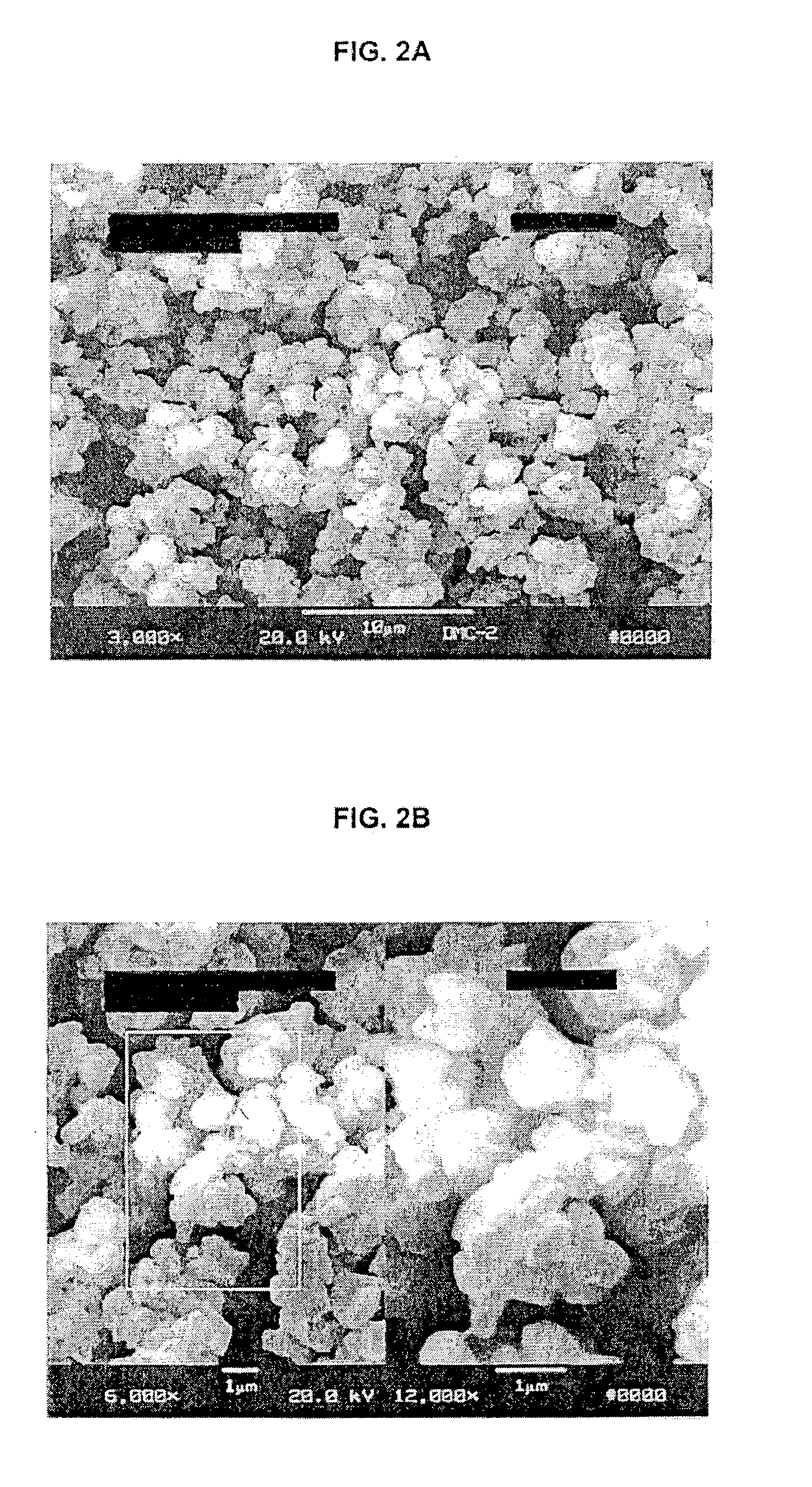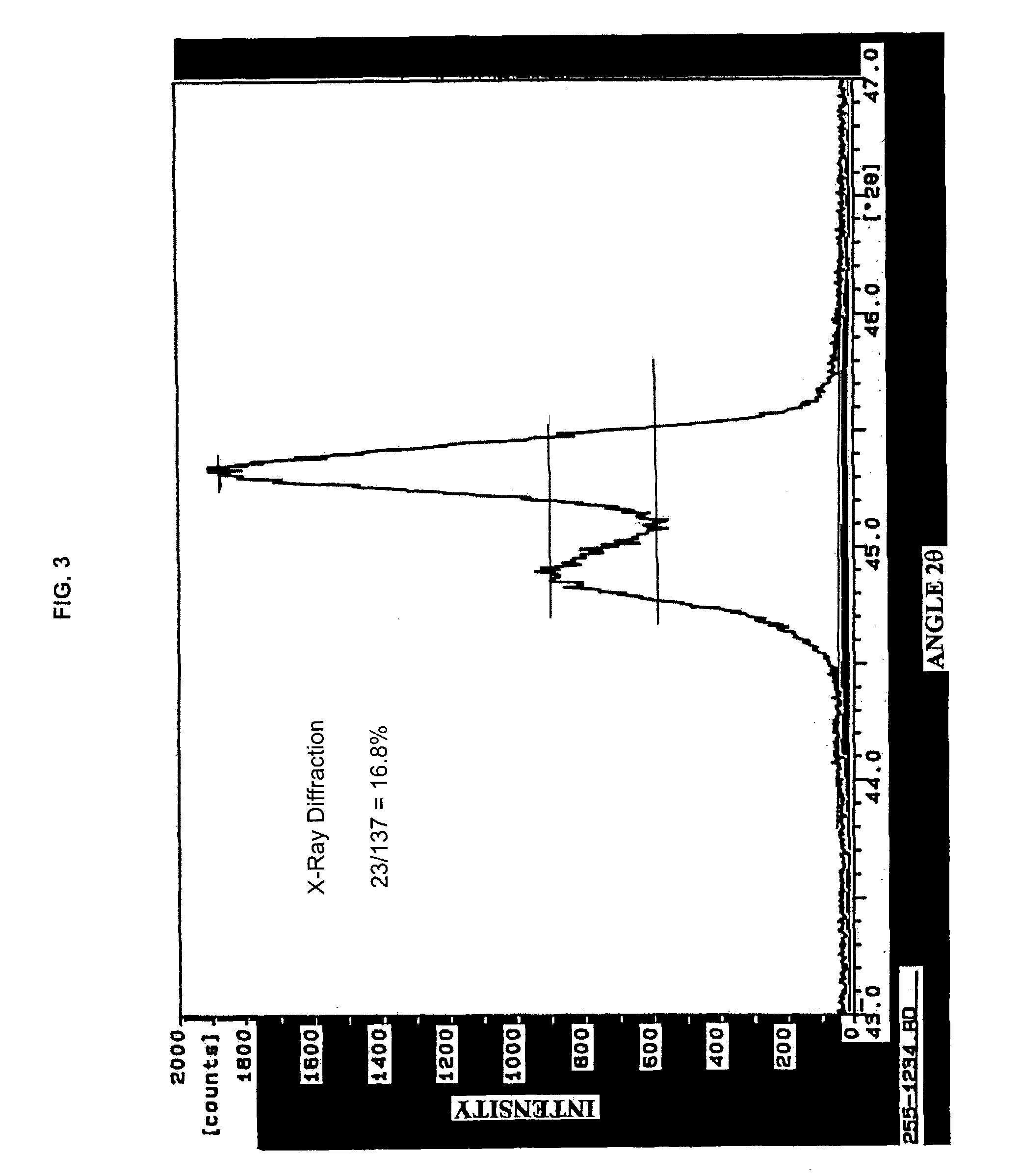Method of making barium titanate
a barium titanate and powder technology, applied in the field of making barium titanate powder, can solve the problems of not widely practiced on a commercial scale, and the formation of bt particles in this manner is subject to ba—ti based phase impurities, etc., to achieve high barium titanate yield, improve volumetric efficiency, and high purity
- Summary
- Abstract
- Description
- Claims
- Application Information
AI Technical Summary
Benefits of technology
Problems solved by technology
Method used
Image
Examples
example 1
[0058]A hydrated BTO precursor was prepared using the following raw materials: technical grade oxalic acid dihydrate (>99% purity) from Aldrich Chemicals; reagent grade barium acetate (99–102% purity) from Spectrum Chemicals; and aqueous acidic TiOCl2 solution with a TiCl4 concentration of 59.2% from Millenium Chemicals. A 5-gallon plastic pail with a diameter of about 11″ and a height of 14″ was used as the reaction vessel.
[0059]3.752 kgs of oxalic acid dihydrate powder was charged to the reaction vessel. 7.5 kgs of DI water was then added. This mixture was agitated with a 4.5″ diameter A-310 HALAR® coated blade at about 500 rpms. A polyproplyene carbuoy was charged with 4.0 kgs of aqueous acidic TiOCl2 solution that was discharged into the reaction vessel under the stirred water level to avoid HCl fuming. After the discharge was complete, the carbuoy was rinsed with 300 grams of DI water, which was discharged into the reaction vessel.
[0060]The initial temperature of the aqueous ac...
example 2
[0068]A series of experiments were run to precipitate hydrated BTO using a range of process conditions. Reagent grade oxalic acid dihydrate (>99% purity) from Spectrum Chemicals, reagent grade barium acetate (99–102% purity) from Spectrum Chemicals, and aqueous acidic TiOCl2 solution with a TiCl4 concentration of 60% from Millenium Chemicals were used in the experiments. An 8-gallon HDPE tank with a diameter of about 12″ and a height of 18″ was used as the reaction vessel.
[0069]The experiments were designed to the study the effects of 5 process variables on the final BTO and BT properties. The variables chosen for study were: (1) the DI / Ti ratio; (2) the oxalic acid dihydrate excess over stoichiometry; (3) the barium acetate excess over stoichiometry; (4) the temperature of the aqueous solution slurry before adding the barium acetate; and (5) the reaction time. The variables and the testing ranges are shown in Table 1 below:
[0070]
TABLE 1EXAMPLEVARIABLERANGE2A–2DDI / Ti Ratio1.9 to3.02...
example 3
[0079]A hydrated BTO was prepared to determine the product yield for the process according to the invention. Reagent grade oxalic acid dihydrate (>99% purity) from Spectrum Chemicals, reagent grade barium acetate (99–102% purity) from Spectrum Chemicals, and aqueous acidic TiOCl2 solution with a TiCl4 concentration of 60% from Millenium Chemicals were used.
[0080]A 4-liter PYREX® beaker was used as the reaction vessel. To this, 747.5 grams of oxalic acid dihydrate powder was added. A total of 1.92 kgs of DI water was used for the reaction. 1700 grams was added initially to the oxalic acid and the remainder was held back for future rinsing of the containers that hold the other chemicals. The aqueous oxalic acid mixture was agitated with a 3″ diameter A-200 Teflon® blade at about 300 rpms. A pyrex beaker containing 800 grams of aqueous acidic TiOCl2 solution was then discharged into the 4-liter beaker. After the discharge was complete, the beaker was rinsed with 100 grams of DI water, ...
PUM
| Property | Measurement | Unit |
|---|---|---|
| particle size | aaaaa | aaaaa |
| molar ratio | aaaaa | aaaaa |
| molar ratio | aaaaa | aaaaa |
Abstract
Description
Claims
Application Information
 Login to View More
Login to View More - R&D
- Intellectual Property
- Life Sciences
- Materials
- Tech Scout
- Unparalleled Data Quality
- Higher Quality Content
- 60% Fewer Hallucinations
Browse by: Latest US Patents, China's latest patents, Technical Efficacy Thesaurus, Application Domain, Technology Topic, Popular Technical Reports.
© 2025 PatSnap. All rights reserved.Legal|Privacy policy|Modern Slavery Act Transparency Statement|Sitemap|About US| Contact US: help@patsnap.com



